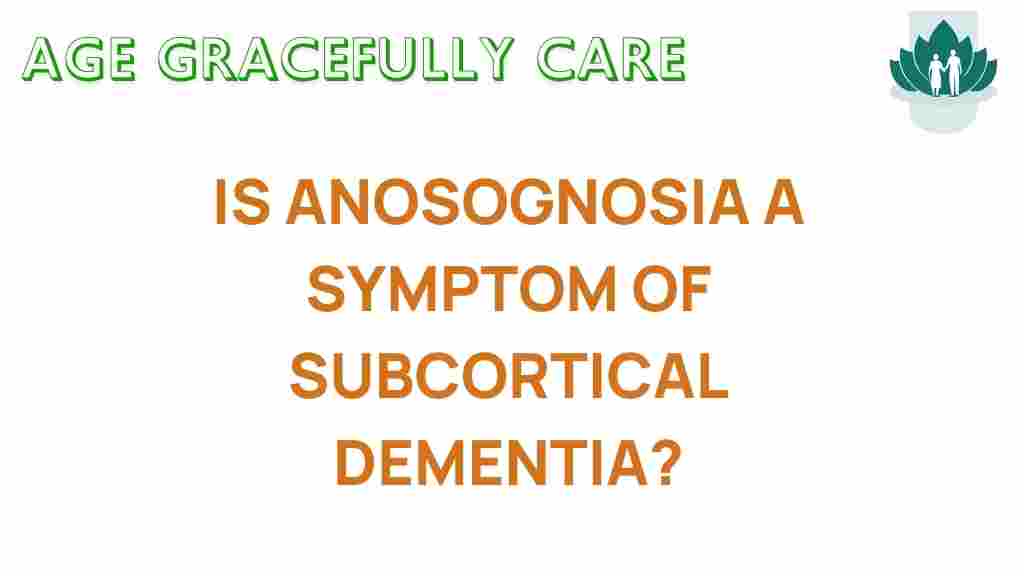Unraveling Anosognosia: A Hidden Symptom of Subcortical Dementia
Anosognosia is a term that refers to a patient’s lack of awareness of their own cognitive decline, which can be particularly pronounced in individuals suffering from subcortical dementia. This condition often manifests in various neurological disorders and poses significant challenges in the assessment and treatment of patients. Understanding anosognosia is crucial for caregivers and healthcare professionals as it directly impacts patient awareness and the management of dementia symptoms. In this article, we will delve into the intricate relationship between anosognosia and subcortical dementia while exploring its effects on brain health, cognitive decline, and memory loss.
Understanding Anosognosia
Anosognosia is not merely forgetfulness; it is a profound unawareness of one’s own impairments. This phenomenon can lead to significant difficulties for both patients and caregivers. Individuals with anosognosia may deny their cognitive deficits, which can hinder their ability to seek care and adhere to treatment plans. The implications of this condition are particularly notable in the context of subcortical dementia.
Subcortical Dementia Explained
Subcortical dementia is a type of dementia associated with damage to the structures below the cerebral cortex. This form of dementia often results from a variety of neurological disorders, including:
- Parkinson’s disease
- Huntington’s disease
- Multiple sclerosis
- Vascular dementia
Patients with subcortical dementia often experience cognitive decline, memory loss, and changes in mood and behavior. The symptoms may progress slowly, sometimes leading to anosognosia, where the patient is unaware of their deteriorating condition.
The Connection Between Anosognosia and Subcortical Dementia
The relationship between anosognosia and subcortical dementia is complex. Anosognosia may stem from damage to specific areas of the brain that are responsible for self-awareness and executive function. When these areas are compromised, individuals may not recognize their cognitive deficits, making it particularly challenging for caregivers and healthcare providers to offer appropriate support.
Symptoms of Anosognosia in Subcortical Dementia
Recognizing anosognosia in patients with subcortical dementia can be tricky. Common signs include:
- Denial of memory loss or cognitive difficulties
- Inability to understand the impact of their condition on daily life
- Resistance to diagnosis or treatment
- Frustration or anger when confronted with their cognitive issues
Understanding these symptoms is crucial for caregivers to provide effective support and encourage patient engagement in their treatment.
The Impact on Brain Health
Brain health is paramount in managing neurological disorders like subcortical dementia. Anosognosia complicates this management, as patients may not recognize the necessity of lifestyle changes, medication adherence, or cognitive therapies. This lack of awareness can lead to:
- Increased risk of falls and accidents
- Neglect of physical health
- Declining social interactions
- Exacerbation of cognitive decline
Healthcare providers must address these concerns, employing strategies that foster patient awareness and encourage a proactive approach to managing their health.
Strategies for Managing Anosognosia
Managing anosognosia in patients with subcortical dementia requires a multifaceted approach. Here are some effective strategies:
1. Education and Awareness
Providing education about subcortical dementia and its symptoms can help patients and their families understand the condition better. This includes:
- Explaining the nature of the disease
- Discussing the implications of memory loss and cognitive decline
- Encouraging open conversations about feelings and fears
2. Supportive Communication
Using supportive and empathetic communication can help patients feel more comfortable discussing their symptoms. Techniques include:
- Active listening
- Validation of feelings
- Avoiding confrontational language
3. Involving Caregivers
Caregivers play a vital role in managing anosognosia. They can help by:
- Encouraging routine medical check-ups
- Assisting with medication management
- Facilitating social interactions
Family members should also be educated about how to approach the topic of cognitive decline gently and effectively.
4. Professional Intervention
Therapists and healthcare providers may employ various interventions, including:
- Cognitive behavioral therapy
- Occupational therapy to enhance daily living skills
- Group therapy for social support
These interventions can provide a structured environment for patients to explore their awareness of their condition.
Troubleshooting Tips for Caregivers
Caregivers may encounter challenges when dealing with patients exhibiting anosognosia. Here are some troubleshooting tips:
1. Identify Triggers
Understanding what triggers denial in patients can help caregivers manage their responses. Common triggers include:
- Confrontational discussions about cognitive decline
- Stressful situations that exacerbate anxiety
- Changes in routine that confuse the patient
2. Create a Safe Environment
Ensure that the living space is safe and accessible to prevent accidents. This includes:
- Removing tripping hazards
- Installing grab bars in bathrooms
- Using labels and reminders for daily tasks
3. Encourage Routine
Establishing a daily routine can provide structure, helping patients feel more secure and less anxious. This may involve:
- Regular meal times
- Scheduled activities or therapy sessions
- Consistent sleep patterns
4. Seek Support
Joining support groups can be incredibly beneficial for caregivers. These groups provide a platform for sharing experiences and gaining insights from others facing similar challenges. Consider exploring resources available at Alzheimer’s Association.
Conclusion
Anosognosia is a hidden yet significant symptom of subcortical dementia that requires careful attention and understanding. By recognizing the connection between anosognosia and cognitive decline, caregivers and healthcare providers can better support patients in navigating their conditions. Through education, supportive communication, and professional intervention, it is possible to enhance patient awareness and improve overall brain health. The journey through subcortical dementia is challenging, but with the right strategies, caregivers can foster a more supportive environment for their loved ones, promoting a better quality of life.
For more information on dementia symptoms and mental health, visit National Institute of Mental Health.
This article is in the category Health and created by AgeGracefullyCare Team
